EdenChain — A Practical Next-Generation Blockchain Embracing the Deep Blue Ocean
The crypto boom in 2017 created an unprecedented level of interest in Blockchain technology and brought in millions of new users to the space. Bitcoin and Ethereum, which are known as Blockchain generation 1.0 and 2.0 projects respectively, face a bottleneck with a sudden influx of demand leading to delayed transactions and high transaction costs. To solve this problem, many infrastructure projects were recently developed to propose new solutions to improve scalability, efficiency and security (Key projects include NEO, EOS, ICON, AION, Kadena and very recently Hyperledger, Oneledger, Quarkchain, Pchain, EdenChain, etc). The competition in this space is getting intense, which is a classic example of “red ocean”, which describes the fact that projects and businesses compete on very similar factors for similar user base leading to overcrowding and inevitable consolidation.
EdenChain, which conducted a very successful ICO in May and raised US$24M, features a programmable economy and permissioned blockchain platform which enables projects and businesses to tokenize and capitalize tangible and intangible assets freely through smart contracts. Eden does not only address the issues related to scalability, efficiency and security, but also adopt a business oriented approach that offers practical solutions and convenience to businesses which have difficulty in the past in accessing Blockchain technology.
In this article we will study how EdenChain’s unique positioning and offerings can help them capture the uncontested demand (a.k.a. “Blue Ocean”) especially in Asia and gain a strong foothold in the global market.
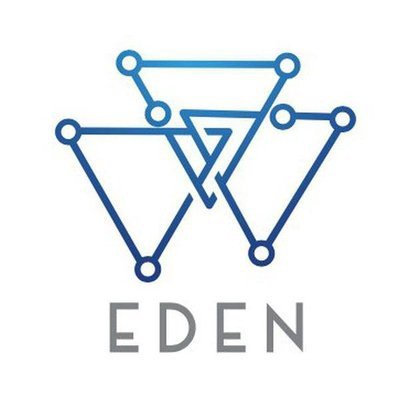
3 Tiers of Potential Users of Blockchain Technology
Before looking into and comparing Eden’s technology with other projects, it is essential to understand who the general end users are in the market. Learning what the users’ pain points are would help us determine which projects are designed to solve their problems, also by estimating the relative market potential and competition of each segment we can project how much potential demand projects can capture.
In general, there are 3 tiers of potential users:
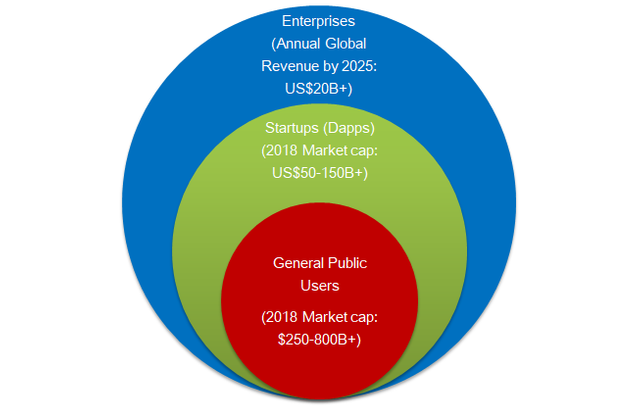
1. General Public Users
Most of the current general public users are crypto investors, including retail investors, traders and institutional investors such as venture capital. They are very passionate and positive about the potential of Blockchain technology that leads them to invest in cryptocurrencies. The market capitalization of cryptocurrencies is ~US$300B as of the date of writing this article (reached ~US$800B at its previous peak) and has the potential to surpass US$1 Trillion in the next few years based on current trajectory. Crypto assets comprise 3 main categories: (1) Digital Currencies (Bitcoin, Litecoin, Monero etc); (2) Infrastructure (platform that allows DApps to be built on it; e.g. Ethereum, EOS, NEO, Cardano, etc) and (3) Token (DApps and soon-to-be-infrastructure-projects that currently depend on another cryptocurrency as a Infrastructure to operate; e.g. Omisego, Tether). The first two categories account for 80–90% of the market capitalization (especially Bitcoin and Ethereum which account for over 50% of the total market capitalization).
General public users generally transact through public chains (e.g. Bitcoin and Ethereum). This group of users requires reasonable level of speed, cost and security, the higher their transaction frequencies are, the higher their requirements are. Growth of this segment depends on whether cryptocurrencies will be widely accepted and become an important medium for transactions or new investment asset class that will attract more new users to own cryptocurrencies; also whether the technology will be more user-friendly and accessible (e.g. improvement in fiat-to-crypto gateway, wallet functions, etc.) to non-tech-savvy users which is currently an under-penetrated segment.
No doubt top public digital currencies/infrastructures especially Bitcoin and Ethereum have high chance to continue to dominate and monopolize the market as they are the most well known and the first movers; and peripheral projects such as lightning network and Casper are being developed to improve their transaction performance in order to capture increasing public demand. There is little room for new projects to gain a significant share of the general public user market given Bitcoin and Ethereum’s dominance.
2. Startups with Decentralized Applications (DApps) as their core products
Startups that build decentralized applications and issue their tokens often have the vision to eliminate intermediaries to redistribute profits back to users, improve security and transparency of information, allow users to retain their data ownership, incentivize the usage of platform through token rewards, etc. They are service providers & product creators that target both public and private users, depending on their business models (B2C or B2B) and niche.
DApp projects leverage infrastructure platforms to build their product and issue tokens. They have several major requirements:
- They have higher requirements on the scalability, security and cost of infrastructure platforms than general public users. The higher the number of customers and transactions they have, the higher their requirements are
- Programming language and the technical documentation of the platform also concern DApp projects, as there is a lack of experienced blockchain engineers in the market for projects to grow their team. An alternative solution is to hire existing software engineers and train them to pick up a new language. If the language is similar to existing languages like JavaScript, C and Python, the learning curve will be less steep
- They require assistance in running their ICOs. Companies with public listing experience would understand the hassle of the IPO process. Getting listed on stock exchange requires a time consuming process working with lawyers to comply with regulations, investment bankers to determine the valuation of the company, auditors to ensure the fairness and reasonable assurance of the financial statements and marketing firms to showcase their company prospect in roadshows, not to mention ICO is a completely different game with additional complexities. Without experienced deal personnel in the company, it would be a very painful process for startups to run their ICOs on their own
It is interesting to note that DApp projects (that issued their tokens) only account for a relatively small portion (~10–20%) of the crypto market capitalization. Recall the start of internet dot com boom during late 90s to the time where popular applications like Facebook were developed during mid 00s, it will take years for a new technology to grow mature and nurture new applications — DApp development is the same case and we can expect to see an explosion in the number of DApps in the next few years. Infrastructures that have a large number of DApps built on them will likely to dominate the market given the spectrum of use cases they can cover — like the situation where Android Play Store and IOS App Store occupy the whole market vs Windows Mobile being a minority platform. Currently Ethereum, NEO, ICON and AION lead the market with the amount of DApps built on them (see chart below).
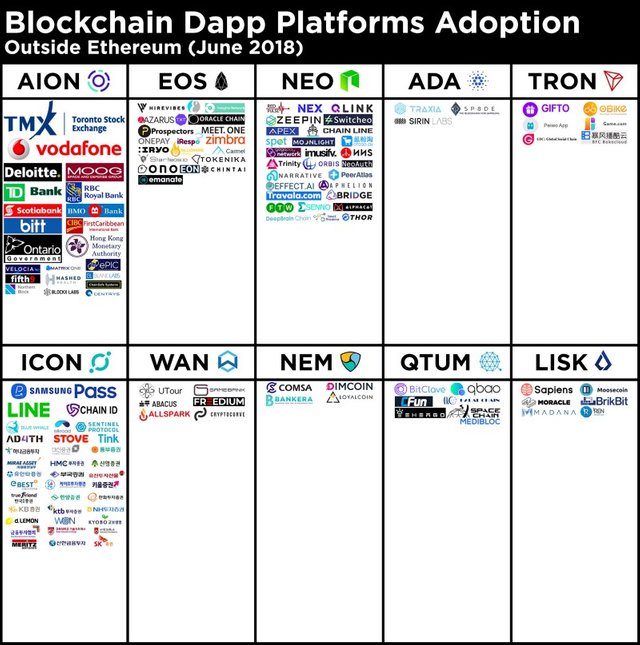
Credits to the infographic creator; Source:
https://imgur.com/YSxuqAI
There remains some opportunities for new infrastructure projects to gain a significant share of the DApps market, given the foreseeable growth of the DApps market and continuing demand for all-rounded infrastructure platforms that can address all the issues mentioned above.
3. Enterprises across different industries
The first two tiers of potential users are more on the public side, but Blockchain technology can also provide benefits for the private side such as enterprises. By integrating Blockchain technology into their internal processes, enterprises can achieve higher revenue potential, save costs, improve security and efficiency through these means:
- Assets tokenization: by tokenizing tangible and intangible assets with economic values (1) ownership can be clearly defined as records on blockchain cannot be modified (especially patent records); (2) liquidity can be improved (especially for immovable assets like properties); (3) securitization of assets is achievable for fractional and shared ownership; etc.
- Reduction in human effort: A single process within an enterprise like payment can involve multiple departments say marketing, procurement, finance, etc that requires multiple approval from the heads of these divisions. By deploying smart contracts processes and orders that involve multi-parties approval can be automated if the predefined conditions are met, saving human effort and time
- More transparent supply chain process: when blockchain is integrated with the procurement, manufacturing and logistics systems the shipping process and the source of the raw materials can be tracked much easily and auditable since information on blockchain is immutable. This helps gain customers’ trust which can result in higher retention rate and revenue
- Reduction in transaction cost: by transacting through cryptocurrencies intermediaries such as payment processors and banks may no longer be required; leading to transaction cost savings
Tech companies usually have rich resources including higher R&D budgets and tech talents so it is not surprising that they are the pioneers to deploy Blockchain technology. Tech giants like Google and Samsung are already working on their own blockchains to support their cloud business or to monitor the manufacturing process (see https://www.bloomberg.com/news/articles/2018-03-21/google-is-said-to-work-on-its-own-blockchain-related-technologyand https://www.bloomberg.com/news/articles/2018-04-15/samsung-jumps-on-blockchain-bandwagon-to-manage-its-supply-chain)
Despite the enormous potential benefits, most of other industries have not yet adopted Blockchain technology in their organization. According to a survey conducted by Gartner (https://www.gartner.com/newsroom/id/3873790), only 9% of CIOs indicated some degree of blockchain adoption currently or in short term; while 34% of CIOs have no interest and 43% of CIOs are aware of Blockchain technology but not taking any actions. The low adoption rate is driven by the following barriers (in addition to the challenges mentioned in the DApp section):
- Lack of full understanding on Blockchain technology: Adopting blockchain technology implies a change in current business and operating models which presents risks and challenges to execution, especially when there is still uncertainty involved in terms of security, regulation, governance, system architecture, etc. Management may be hesitant to take immediate action before a complete understanding
- Insufficient resources and expertise to adopt the technology: Unless there is an ICO to raise funds, enterprises need to spare addition budget to invest in blockchain adoption. Unless a significant benefit can be quantified, it may not be economically viable for any investment if the cost of adoption is too high. Also as mentioned there are currently not enough blockchain engineers and other blockchain related talents (e.g. lawyers) available in the market which is also a huge barrier for adoption
- Lack of enterprise-fit solutions in the market: (1) Existing public blockchains currently do not meet the security and privacy requirements for enterprises as information is accessible by anyone without restrictions. Distributed ledger technology brings transparency but it does not mean companies would like to reveal confidential business information to their competitors, or even to a group of employees within the enterprise. (2) Existing blockchains are unable to offer simple solutions to integrate with existing company systems. There can be hundreds of enterprise systems such as SAP, Business Databases & Warehouses, POS systems, etc with different architectural designs and standards that create complexity to integration. Without a simple bridging interface and security
protocol, enterprises find it difficult to connect blockchains with existing systems easily and securely
It is hard to measure the potential market size of the enterprise blockchain market through market capitalization as enterprises may not issue tokens or tokens may not be tradeable in the market. Another way to measure market size is by revenue. Some studies indicate that enterprise application of blockchain can bring in US$20 billions annual revenue by 2025 globally, which is 8 times more than today. (see https://next.autonomous.com/insights/2030-projection-of-blockchain-technology-marketand https://www.prnewswire.com/news-releases/global-blockchain-for-enterprise-applications-market-report-2016-2025-analysis-of-the-199-billion-market-with-profiles-of-22-key-industry-players-across-19-industries---research-and-markets-300415819.html)
As the enterprise segment will continue to grow and there are still inadequate enterprise-fit solutions available in the market, projects that can help tackle the key adoption challenges will capture a fruitful share of this ‘Blue Ocean’ without doubt.
EdenChain’s Architectural Design
EdenChain comprises three distinctive layers: distributed ledger, validation layer and the bridge layer.
Distributed Ledger Layer (DLL): The distributed ledger layer is based on Hyperledger Sawtooth that provides the decentralized database function to store data on blockchain separately. Only transaction data agreed to in the validation layer are processed and added to the DLL
Validation layer: Transactions are executed and verified in the validation layer. Feature wise, Ethereum Virtual Machine (EVM) is built in this layer to run the smart contract; and a transaction scheduling function is included to
optimize performance and scalability.
Bridge Layer: The bridge layer is fundamental to secured interoperability and connectivity between on-chain and off-chain systems, in which off-chain data requested by on-chain smart contract is imported and transmitted securely through an E-Protocol that implements Elliptic Curve Cryptography –Threshold Cryptography (ECC-TC) encryption method to ensure reliable communication between the nodes.
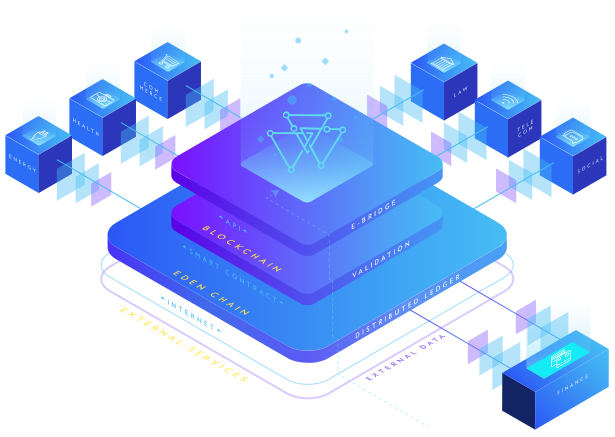
Source: https://edenchain.io
EdenChain’s Positioning in the Blockchain Space
Instead of just solving common problems in blockchains such as speed, transaction cost and interoperability; Eden goes an extra mile by improving security & privacy of its blockchain further, making it more user-friendly & accessible and providing an one-stop solution for projects and businesses. All of the technology Eden uses has also been proven to ensure its feasibility. The chart below shows that Eden positions itself as a reinforced (private) permissioned blockchain that enables it to fulfill DApp and enterprise users’ needs and solve their problems better.
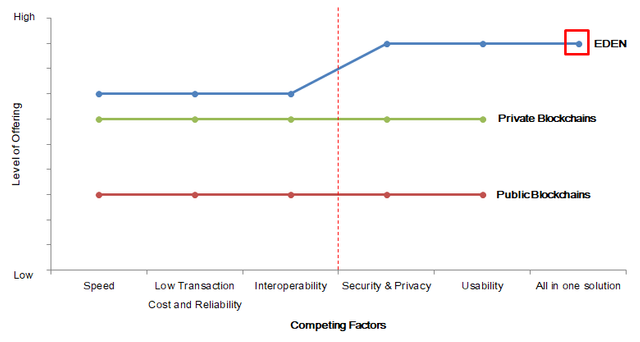
1. Speed
First and second generation public blockchains like Bitcoin and Ethereum can only process ~7 and ~25 transactions per second (TPS) respectively. The challenge that public blockchains face is that every transaction must be processed by every participating node on the network, and every node has to maintain a entire copy of state — which implies a continuous increase in bandwidth, computing power, storage, etc is required (especially for Bitcoin’s Proof-of-Work algorithm) in order for public blockchains to scale to satisfy growing public demand. Because of that, latest third+ generation blockchains propose to deliver a speed of millions+ TPS by introducing more efficient consensus algorithms such as Delegated Proof of Stake (DPoS) and Byzantine Fault Tolerance (BFT) or even implementing advanced technology such as sharding to achieve scalability.
Private blockchains generally enjoy faster speed than public blockchains as the validators are usually known (i.e. less trust issue) and therefore transactions can be validated by fewer nodes that allows the use of consensus algorithm with much shorter block time to reach finality.
To optimize performance for both public and private use cases, Eden utilizes Merkle tree and namespace technology that groups related transactions and separates unrelated transactions to allow parallel transaction processing. Each namespace can perform ~1,000 TPS and EdenChain can theoretically be scaled linearly to infinite TPS with additional computing resources as there is no limit in the number of namespaces & transactions per namespaces and no data consistency issue.
Eden adopts an energy-efficient consensus algorithm, Proof-of-Elapsed-Time (PoET), which is originally created by Intel. PoET works similar to Bitcoin’s Proof-of-Work (PoW) that selects a leader (which solves the hash puzzle, authenticates previous block and creates a new block) through a random lottery process, except the fact that PoET is designed to consume far less electricity than PoW. PoET works in a way that it generates a random wait time that every participating node has to finish the wait time to be eligible in the leader selection, and the participating node with the shortest wait time wins as the leader. During the wait time, participating nodes are allowed to sleep or switch to other tasks which results in energy saving and efficiency improvement.
Eden’s scalable platform allows large scale DApps to be built on it with superior performance and applied across hundreds and thousands of real life use cases.
2. Transaction fee and reliability
Transaction fees on public blockchains like Bitcoin and Ethereum become very high during high traffic situation as miners are incentivized to include only the transactions that pay high fees in the blocks. As a result, some transactions that offer miners low transaction fees may be dropped out, which makes public blockchains not suitable for enterprise users as transaction certainty is one of their key criteria to operate their businesses.
Private blockchain transactions are usually less costly, since they can be validated by fewer nodes trusted to have high processing power, which works better for enterprises. Third+ generation blockchains also manage to reduce transaction fee by introducing more efficient consensus method as mentioned.
Eden charges a low and fixed transaction fee and makes sure 100% of the transactions are processed in a First-In-First-Out (FIFO) sequence. No transactions will be left out ensuring Eden to be reliable for enterprise use.
3. Interoperability
The first and second generation blockchain projects cannot communicate with other blockchains. The third generation projects like ICON, AION and Wanchain begin to emphasize interoperability among Blockchains to relay messages for data transfer and carrying out transactions. Another type of interoperability between blockchains is cross-chain atomic swap, which allows cryptocurrencies to be swapped with one another directly without an intermediate cryptocurrency (ETH/BTC/USDT), which is developed specifically for decentralized exchange (DEX) use cases.
Interoperability is not only confined to on-chain communication between blockchains, but also off-chain interactions. In reality most of the existing enterprise systems are not blockchain systems (i.e. off-chain systems) so off-chain interoperability is an essential function of enterprise blockchains. Eden incorporates E-Oracle in its Bridge layer to interact with off-chain systems. The off-chain module accesses, retrieves, verifies and selects requested data from off-chain systems, then passes on to the on-chain modules to execute the smart contracts. On the other hand, by providing APIs and SDKs for developers, interoperability is also achievable at application level.
4. Security and Privacy
Some public blockchains such as Ethereum are originally designed to be permissionless that data and smart contracts are stored and run on all nodes for every person on the network without restricted access. This is the one of the advantages of public blockchain that all transactions are fully transparent and trackable on public ledgers so it increases the difficulty in commiting frauds. Public blockchains are also more secure than centralized servers as attackers need to control majority of the nodes (a.k.a 51% attack) to fork the blockchain and manipulate the records. However, public blockchains are not designed to meet the escalated enterprise security and privacy requirements, that gives rise to rapid development of private permissioned blockchains.
EdenChain is a permissioned blockchain, as the name suggests, it requires permission from authorized administrators to participate in the network. This is important especially to enterprises as sensitivity business information cannot be revealed to the public or even between different divisions within the same enterprise as discussed in the first section. By granting access to selected individuals and requiring multi-signature approval, private permissioned blockchain can ensure proper internal control and solid corporate governance.
Comparing with general private blockchains, EdenChain improves security and privacy further for enterprises by the followings:
- operating the Eden system in multi data centers on clouds across major continents to ensure high availability, which are connected in a secure ecosystem through Virtual Private Network (VPN), customizable
function-specific firewall, global DNS and load balancer - separating on-chain modules from off-chains modules in the Bridge layer into different networks; their communication is routed through HTTPS and protected and encrypted by Elliptic Curve Cryptography — Threshold Cryptography (ECC-TC) to shield on-chain modules from attacks in external system and hence ensure zero-knowledge trusted connectivity
- adopting Median Voter Theorem (MVT) as a consensus algorithm for validating continuous data in E-Oracle servers. MVT has low vulnerability to attacks
- implementing the PoET and MVT algorithms in an Software Guard Extensions (SGX) enclave to protect the leader lottery process against attacks
5. Usability (Ease of Access, Use, Organization)
Eden is designed to speed up the learning curve. Instead of creating a new programming language for blockchain operations that may create a learning barrier, Eden’s Transaction Execution Scheduler (TES) in the execution layer
includes Ethereum Virtual Machine (EVM) to read and execute smart contracts written in Solidity, which is already the most popular language to write smart contracts.
For developers who do not know Solidity, Eden provides a developer portal called E-Edge that provides API calls for various functions that are required to develop blockchain services with enterprise blockchain platforms. Developers can register services that use the Eden platform & obtain namespace through the portal; and a secret key will then be assigned to them for accessing the APIs. E-Edge helps reduce enterprises’ adoption cost as their existing developers can simply use the APIs to build blockchain services without the need to hire new blockchain developers. The MVP of E-Edge has already been released (for full details please refer to https://EdenChain.io/mvp-preview-part-2-e-edge/)
Eden also improves the traceability, organization and control of transactions. A namespace can be added as a delimiter to indicate the nature of transaction (e.g. name ‘Vendor_A’). The validator nodes can use the namespace information to group transactions in batches so that dependencies between transactions can be easily observed. Since transactions within the same batch are inter-related, when there are errors in a particular transaction, one or all of the transactions in the same batch is/are invalidated. This is important to enterprises as transactions are frequent and complicated that often involves multi-parties therefore having such feature allows enterprises to trace & organize information quickly to fix problems and ensure proper control by avoiding potential chain reaction of errors.
6. All-in-one solution
As discussed in the first part, one of the biggest hassles for startups and enterprises is the lack of experience, resources and expertise in adopting blockchains or running their ICOs. There are also insufficient tailor-made
solutions that are readily available in the market for different industry use cases. EdenChain understands the pain and this inspires them to introduce a few services and platforms that expand their industry use case coverage:
- HelloEden is the first ICO platform in South Korea. With the partnership with M&K, one of the top Tech PR and Marketing firm in South Korea, Eden provides not only coin release but a full range of services including marketing and investment to aid startups and businesses in launching their ICOs successfully. Alpha of HelloEden will be available in Q2 2018
- CleanDeal is a B2B ecommerce platform operated by YT Corp that utilizes Eden platform to provide coin release and blockchain technology required for B2B transactions. CleanDeal platform is planned to be launched in Q4 2018
- MyCreditChain is a P2P finance platform operated by Finger, one of the top Fintech companies in South Korea, that utilizes Eden platform to provide coin release and blockchain technology required for P2P finance transactions
The initiative to provide an all-in-one solution is the biggest differentiator of EdenChain as it solves one of the biggest pain points of startups and enterprises that most blockchain projects do not offer.
Strong Execution Leads to Success
While the product-solution fit is one of the key ingredients to success, a business has to be executed well to reach its full potential. Eden has a strong team and a robust partnership network to realize its global vision.
Eden’s team and advisors consist of experienced business and IT professional with rich entrepreneurial experience:
- James Ahn, the CEO and founder of EdenChain, has 20 years of experience in the IT industry knowing what enterprises need in terms of technology. He was previously the CTO in CyberRenassance Inc., Japan. After that he also served as the representative in DeepNumbers and MHR and the consultant to NIA Platform
- Kangho Kim, Chief Strategy Officer of EdenChain, has over 10 years of experience in the financial market as a derivative trader, an analyst and a portfolio manager at reputable global investment firms such as Franklin Templeton. In addition to his finance background, Kangho gains IT experience when he founded a social network mobile application with the use of Blockchain technology and he also serves as a member of the Society of Blockchain Developers in Korea
- HJ Moon, Chief Financial Officer of EdenChain, was an equity research analyst in top global investment banks like Goldman Sachs and Barclays Capital. HJ is also a blockchain enthusiast that he later co-founded the social network mobile application
- Eden’s developer team is also led by Jenny Ryoo, Co-founder of EdenChain and a big data and data science expert with over 10 years of IT experience. Eden will also ramp up its developer team to 30–50 people by the end of 2018
- Eden shows a list of 13 notable advisors on their website, one of them is Ben Godenzi, the co-founder of Interoperability Alliance (IOA), who can help Eden establish a strong relationship with IOA
Eden also understands the importance of having a broad and diverse global partner network to realize its value. Through the collaboration with partners, Eden can deepen their understanding on user requirements to refine their products and build more use cases to cover new sectors (e.g. Gaming, Internet of Things, Fintech, Shared Economy) that will encourage further adoption of the platform. Here are some key partners Eden is working with to provide their portfolio startups and enterprises with the Eden platform and advisory services to build permissioned blockchain services, DApps and conduct (reverse) ICOs:
- Across Asia Alliances (AAA) — Across Asia Alliances is an alliance formed by 21 accelerators/incubators in Asia with Asset Under Management over $700m and over 780 startups in the portfolio
- ROA Invention Lab — ROA Invention Lab has an impressive portfolio of companies with high-tech development in areas such as machine learning, O2O/eCommerce, fFntech, etc. It also runs an accelerator program to incubate startups
- Hyperledger — A open source community with over 200 organizations from over 25 countries focusing on cross-industry blockchain advancement
- Other partners include Byzantine Partners, Microsoft Partner Network, Spatium, AssureAsia, Merculet, Tomochain, Block Media, BeNative Pro, etc
Eden has managed to prove part of the feasibility of the project with the launch of two MVPs, one of which is the E-Edge discussed in earlier section, another one is the E-Explorer which works like the Ethereum’s Etherscan to view information about EdenChain blocks and transactions (for details please refer to https://EdenChain.io/preview-of-the-mvp/;
https://edenchain.io/demo-of-e-explorer-mvp-the-first-among-many-products/). The testnet of EdenChain will be available in Q4 2018 and the mainnet launch is targeted in Q1 2019.
Implications of EdenCoin to Token Holders and Users
While the cryptocurrency market is highly volatile and speculative, EdenChain is a long term project and having a more stable token value in long run is important for real platform users as the token value will represent the cost of using the service which has to be predictable. Therefore, in addition to the tactic that the ICO tokens will be distributed equally over 5 months, EdenCoin will provide strong utility to realize and stabilize its value in long run:
- Node participants will be required to hold certain amount of EdenCoin to host masternodes;
- Service providers need to pay EdenCoin as a deposit to provide blockchain services;
- Consumers have to pay EdenCoin to access the services of service providers;
- Eden will provide a secured wallet with enhanced security. To use the secured wallet, a fee/deposit has to be paid using EdenCoin
A hyperdeflation model is introduced that the coin supply will decrease gradually at a steady rate by 2020 through coin burn(cancelled due to regulatory concerns)
Conclusion
With EdenChain’s practical approach that (1) uses proven technology to strengthen security, scalability & performance of permissioned blockchains; (2) emphasizes usability of the platform and (3) provides an one-stop solution with advisory services that removes a huge barrier for startups and enterprise users to adopt blockchain technology, Eden shows they are ready to embrace the Blue Ocean and they are definitely a strong contender to be one of the top global blockchain projects in the foreseeable future. Here we wish Eden’s team all the best to successfully achieve their ‘Garden of Eden’ vision for the advancement of global blockchain adoption.
✅ @acwtkae, I gave you an upvote on your post! Please give me a follow and I will give you a follow in return and possible future votes!
Thank you in advance!
Cool, thanks for sharing.
I liked the write up. I have upvoted and followed. Pls check my article on eden
I've been asking EdenChain if they have already resolve the technical issues they are facing right now. They're not responding to me even in their group chat. All I receive is "wait for future announcements" so I don't know when will I wait and my funds are in the high risk of losing. Maybe it's much better if I didn't invest in them at the first place.
I don't see any technical issues about EDN lately, their team is focusing on the development of the project that's why they locked the token. I think it will be released when it gets listed on kucoin. I've also been waiting just like you, but the difference is that I see how future will be with EDN. You haven't realize it yet, maybe eventually you will. When token is unlocked, grab the chance right away and then keep it and hodl.
You'll not lose dude actually the price of this project continue to increased. Also the price of EDN now is really worth to invest. So acceptable because i know they faced a lot of queries too that they need to fixed and maybe your the next in their line up. This also happens in some projects. If you are an old trader in crypto this issue is slightly considerable.
Congratulations @acwtkae! You received a personal award!
You can view your badges on your Steem Board and compare to others on the Steem Ranking
Vote for @Steemitboard as a witness to get one more award and increased upvotes!